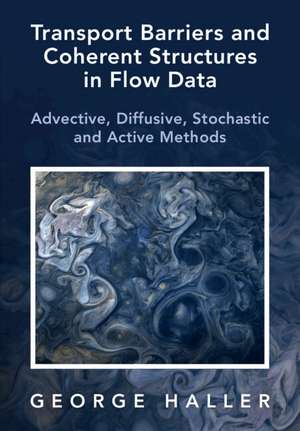Transport Barriers and Coherent Structures in Flow Data: Advective, Diffusive, Stochastic and Active Methods
Autor George Halleren Limba Engleză Hardback – 15 mar 2023
Preț: 569.36 lei
Preț vechi: 618.87 lei
-8% Nou
Puncte Express: 854
Preț estimativ în valută:
108.95€ • 116.50$ • 90.84£
108.95€ • 116.50$ • 90.84£
Carte disponibilă
Livrare economică 28 martie-11 aprilie
Livrare express 13-19 martie pentru 50.91 lei
Preluare comenzi: 021 569.72.76
Specificații
ISBN-13: 9781009225175
ISBN-10: 1009225170
Pagini: 426
Dimensiuni: 182 x 260 x 24 mm
Greutate: 1.02 kg
Editura: Cambridge University Press
Colecția Cambridge University Press
Locul publicării:Cambridge, United Kingdom
ISBN-10: 1009225170
Pagini: 426
Dimensiuni: 182 x 260 x 24 mm
Greutate: 1.02 kg
Editura: Cambridge University Press
Colecția Cambridge University Press
Locul publicării:Cambridge, United Kingdom
Cuprins
1. Introduction; 2. Eulerian and Lagrangian fundamentals; 3. Objectivity of transport barriers; 4. Barriers to chaotic advection; 5. Lagrangian and objective Eulerian coherent structures; 6. Flow separation and attachment surfaces as transport barriers; 7. Inertial LCSs: Transport barriers in finite-size particle motion; 8. Passive barriers to diffusive and stochastic transport; 9. Dynamically active barriers to transport; Appendix; References; Index.
Recenzii
'This is a must read for anyone interested in data-driven fluid mechanics. Coherent structures are central to how we understand fluids, and Haller has been a pioneer in this field for decades. This book covers an exciting range of topics from introductory to advanced material, complete with beautiful graphics and illustrations.' Steven L. Brunton, University of Washington
'George Haller has written a clear, well-illustrated text that step-by-step explains the mathematics needed to understand and quantify fluid motions that cause mixing and describes and identifies the corresponding transport barriers to mixing processes. The ideas are introduced in a systematic way, with examples that highlight analytical features, software available via github, and interpretations to help the reader build intuition for the mathematical concepts and their application to physical processes.' Howard A. Stone, Princeton University
'Dynamical systems theory was developed in the 1980s, but for fluid dynamics has not played the prominent role it deserves. The present insightful and well-written book `Transport Barriers and Coherent Structure in Flow Data' by George Haller now bridges this gap between modern fluid dynamics and dynamical systems theory. It is based on mathematically grounded and solid methods, which are then applied to fluid dynamical problems and data sets. It also includes the usage of modern data-driven methods. The book is complemented by clickable links to a library of numerical implementations of transport barrier detection methods. It is a wonderful textbook for Turbulence and Advanced Fluid Mechanics classes for students in Applied Mathematics, Physics, and Mechanical and Chemical Engineering alike and unmissable for scientists working at the interface between dynamical systems theory and fluid dynamics.' Detlef Lohse, University of Twente
'George Haller has written a clear, well-illustrated text that step-by-step explains the mathematics needed to understand and quantify fluid motions that cause mixing and describes and identifies the corresponding transport barriers to mixing processes. The ideas are introduced in a systematic way, with examples that highlight analytical features, software available via github, and interpretations to help the reader build intuition for the mathematical concepts and their application to physical processes.' Howard A. Stone, Princeton University
'Dynamical systems theory was developed in the 1980s, but for fluid dynamics has not played the prominent role it deserves. The present insightful and well-written book `Transport Barriers and Coherent Structure in Flow Data' by George Haller now bridges this gap between modern fluid dynamics and dynamical systems theory. It is based on mathematically grounded and solid methods, which are then applied to fluid dynamical problems and data sets. It also includes the usage of modern data-driven methods. The book is complemented by clickable links to a library of numerical implementations of transport barrier detection methods. It is a wonderful textbook for Turbulence and Advanced Fluid Mechanics classes for students in Applied Mathematics, Physics, and Mechanical and Chemical Engineering alike and unmissable for scientists working at the interface between dynamical systems theory and fluid dynamics.' Detlef Lohse, University of Twente
Notă biografică
Descriere
Explore a wealth of proven mathematical methods for uncovering transport barriers in numerical, experimental and observational flow data.
